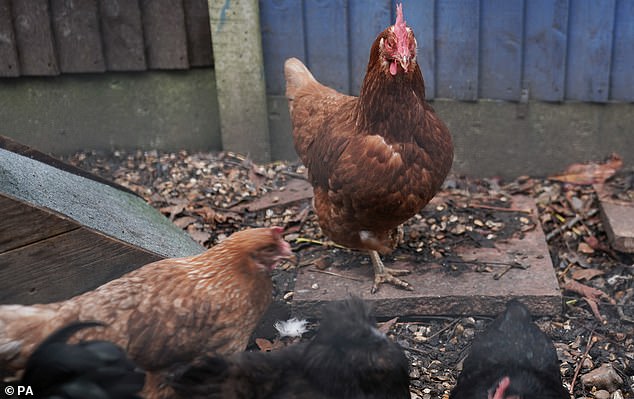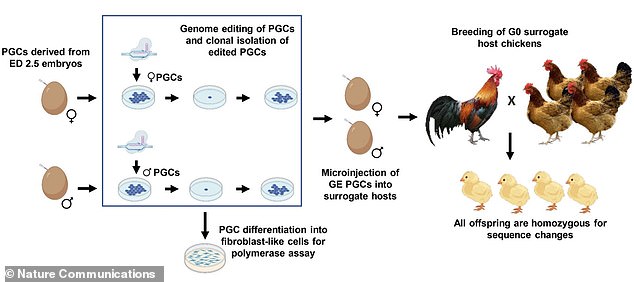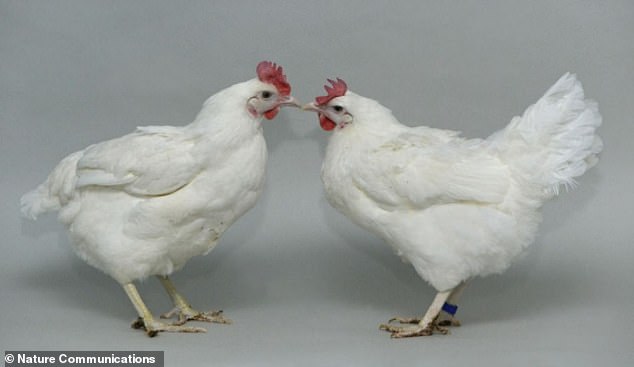Is this the key to curbing the spread of bird flu? Scientists genetically engineer CHICKENS that are resistant to avian influenza
>
A new study shows that gene editing techniques can stop the spread of bird flu among chickens and reduce the risk of it being transmitted to humans.
British scientists used CRISPR-Cas9, a powerful gene-editing tool, to restrict – but not completely prevent – avian influenza virus from infecting chickens.
Introducing genetically modified lab-grown chickens onto farms could limit the spread of the disease, which has cost the UK poultry industry more than £100 million.
Although the team’s method is designed only to prevent the spread of bird flu from chickens to chickens, it can also reduce the risk of chicken-to-human transmission.
Only rarely do strains of avian influenza — also known as bird flu — spread to humans, although experts worry the outbreak could be the next big pandemic.

An ongoing outbreak of bird flu in the UK – caused by the H5N1 strain – has left up to one million birds infected with the virus

Scientists edited the ANP32A gene in chicken germ cells (precursors of reproductive cells) to restrict avian influenza. They found that fully grown chickens were resistant to a dose of the virus
The new research was led by scientists at the University of Edinburgh, Imperial College London and the Pirbright Institute in Surrey.
Lead researcher Professor Mike McGraw, from the Roslin Institute at the University of Edinburgh, said: “Avian influenza poses a major threat to bird populations.”
“Vaccination against the virus presents a number of challenges, with significant practical and cost issues associated with vaccine deployment.
“Gene editing offers a promising path toward durable disease resistance, which can be transmitted across generations, protecting poultry and reducing risks to humans and wild birds.”
Gene editing changes an organism’s DNA in ways that can be inherited by subsequent generations.
Many gene editing techniques allow genetic material to be added, removed, or changed at specific sites in the genome, the complete set of DNA instructions contained in a cell.
For the project, scientists used the popular genome-editing tool CRISPR-Cas9, which is used to make precise edits in DNA.
CRISPR-Cas9 has been likened to a pair of genetic scissors, allowing small snippets of DNA to be removed and replaced.

CRISPR is a DNA editing technology in which scientists can program a molecule to target and “cut out” a specific section or element of a person’s genetic material (archive image, not size measurement)
They edited a portion of the DNA responsible for producing a protein called ANP32A in chicken germ cells (precursors of reproductive cells).
During infection, influenza viruses hijack ANP32A to help replicate themselves.
Once fully grown in the laboratory, 10 genetically modified chickens were exposed to a normal dose of the strain of the virus that causes bird flu.
The researchers found that the vast majority of chickens – nine out of 10 – remained uninfected and there was no spread to other chickens.
The birds showed no signs that the change in their DNA had any effect on their health or egg laying, according to the team.
To further test the birds’ tolerance, the scientists then exposed the genetically modified birds to a much higher dose of the virus.
When exposed to the high dose, half the group – five out of 10 birds – became infected, although the genetic modification offered some protection.
They found that the amount of virus in infected transgenic chickens was much lower than the level typically seen during infection in non-transgenic chickens.
Importantly, the genetic modification also helped limit the spread of the virus to just one out of four normal, non-genetically modified chickens housed in the same incubator.
This highlights the potential of modification to stop the spread of avian influenza among natural, unmodified chicken populations.
As expected, there was no transmission from one genetically modified bird to another.

On the left, a regular chicken and on the right, a genetically modified chicken from experiments. “Chickens genetically resistant to avian influenza could prevent future outbreaks,” the authors say.

Avian influenza represents a major global threat, having a devastating impact on both farmed and wild birds. In the UK alone, the current H5N1 avian influenza outbreak has decimated seabird populations and cost the poultry industry more than £100 million in losses. Pictured, a National Trust ranger removes dead birds from Staple Island, Northumberland, in July 2022
Researchers say that additional genetic changes are needed for the virus to infect humans and spread effectively, as a result of mutations.
Currently, no human-to-human transmission of the virus has been detected in the UK, but some Britons have tested positive for the disease.
Professor James Wood, from the University of Cambridge’s Department of Veterinary Medicine, said the new work shows “significant but not absolute resistance of chickens to bird flu”.
Professor Wood, who was not involved in the study, said: “This study provides important evidence of the principle of genetic control of avian influenza and its transmission among chickens.”
“(It) provides an important proof of principle for the utility of using gene editing to introduce genetic resistance to diseases caused by influenza into farm animals.
“The use of genetically modified, disease-resistant chickens in agriculture would be an exciting advance, and the hierarchical structure of the global poultry industry could allow the rapid introduction of these influenza-resistant chickens in many countries and continents.
“The results must first be proven on a larger scale before they can be introduced into commercial agriculture.”
The study is published in the journal Nature Communications.
(Tags for translation)dailymail
